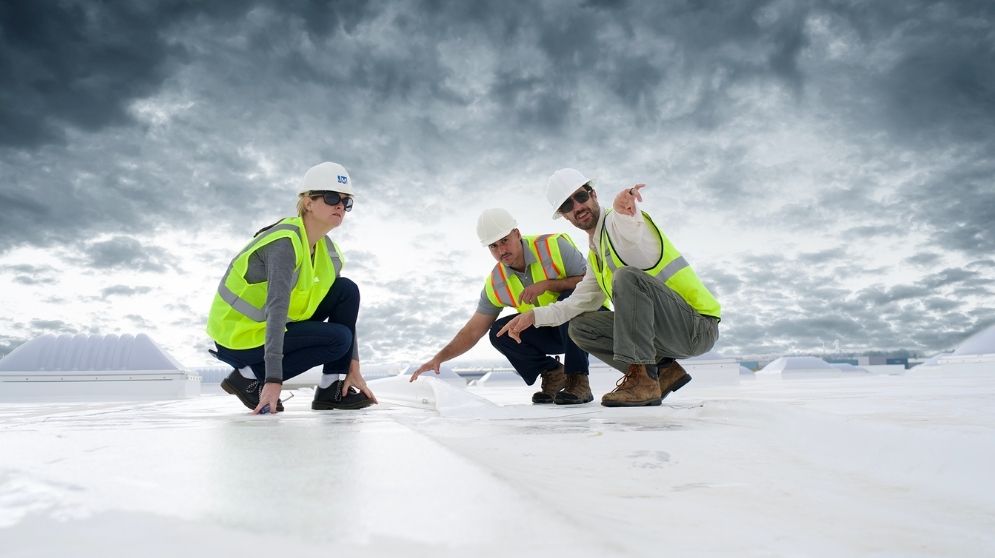Extreme weather conditions continue to be a focus of news stories around the world. High winds from hurricanes or tornadoes, flooding from heavy rain, droughts with long periods of intense sun, high heat, and severe cold all can impact our life activities and our buildings. While not all weather events happen everywhere, the approach to creating buildings—and roofs in particular—that can survive nature’s onslaughts is similar across the different conditions.
The first thing to recognize is that the whole roofing system, not just the membrane, is one of the most vulnerable parts of a building during a weather event of any type. This is particularly true in a commercial building with a low-slope roof construction. Consider that during severe weather, the roof could be exposed to high winds, hail, accidental puncture, unusual snow loads, or intense UV exposure from the sun—all of which could compromise the protective barrier that the roofing is meant to provide.
While damage or failure to the roofing membrane is problematic in its own right, roof performance during a storm also requires attention to the roofing substrate, insulation, fasteners, adhesives, joints, edge conditions, and structure below. In short, all components of the roofing system need to work together to withstand what comes its way to prevent exposing other parts of the building, equipment, critical building systems, and the people inside to the ravages of weather events. Hence, with the short-term and long- term integrity of the building at stake—not to mention human safety—a coordinated approach is needed.
Let’s first consider resistance to precipitation, which can take the form of rain, hail, snow, sleet, ice, or other water- and temperature-based conditions. The membrane will take the brunt of whatever hits it, but so will the substrate or insulation underneath it. Some membranes may be tested and warranted against hail damage, particularly if they are heavy-duty—for example, 75-mil or 90-mil products (manufacturers should be consulted on this point). Roofing systems that employ a protective layer above the membrane, such as ballasted EPDM, may also protect the membrane from hail damage. However, that may not be practical or allowable in areas that experience high winds where ballast or scrim can become a flying debris hazard.
The board and insulation underneath need to be able to withstand point impacts too, because they will telegraph through the membrane. Therefore, the membrane and substrate need to be selected to work together. Additionally, heavy rain and snow may mean that more water ends up sitting on the roof longer than usual, causing seams, flashings, and other joints to be stressed beyond normal conditions. All of those details, then, need to be designed and constructed to anticipate the worst-case scenario so they hold up when storms hit.
Wind is another significant component to many severe weather conditions, and the roofing industry has a long history of addressing resistance to wind uplift. When wind blows across the top of a building, it creates a low-pressure condition above the roof, with a typically higher pressure present beneath it. The roof is literally being lifted up by the force of the wind.
This force, and the resistance needed to keep it down, is measured in pounds per square foot (psf) of uplift resistance. FM Global (FM) is a widely recognized organization that measures wind uplift and has documented standards for testing and reporting of roofing performance. FM typically classifies such reports on the basis of pressures from 60 psf to 999 psf (FM 1-60 to FM 1-999).
Achieving higher wind resistance ratings is not commonly about the membrane, but about the method of installation. For example, in a mechanically fastened roof, the fasteners will play a key role in determining wind uplift resistance, but so will the materials that the fasteners penetrate. Hence the whole assembly, from the structural deck through the insulation /board layers and up to the membrane, needs to be tested together in order to receive an uplift resistance rating. Further, enough area has to be tested to assure that the spacing of fasteners is adequate to achieve the desired results. In a fully adhered system, the adhesive is a focus, but so is the rest of the system that it adheres to. These systems also need to be tested as a complete assembly to determine their ability to perform in high wind situations.
To find out more about different roofing systems and the ways to help them resist and survive through extreme weather, contact your Johns Manville representative.

